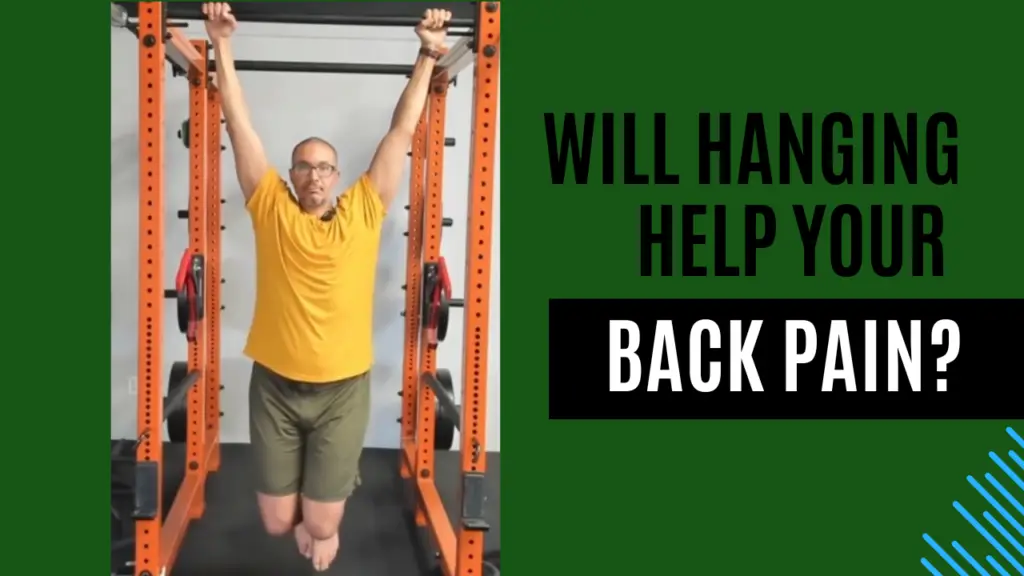Back pain affects over 550 million people worldwide, and with that kind of number, it’s no surprise people are searching for relief—fast. One of the more popular trends? Hanging from a pull-up bar to decompress the spine. But is this method really helping, or could it be doing more harm than good?
Let’s break it down through a holistic, fascia-informed lens, so you can understand what’s really happening when you hang—and whether it’s a smart choice for your back.
Click on the image to watch the full video

🔍 Why People Hang for Back Pain
The theory is simple: when you hang, your body weight creates a gentle pull on the spine, which seems to decompress the vertebrae. It’s popular among physical therapists and fitness influencers who promote spinal decompression as a fix for bulging discs, tight backs, or just general discomfort.
But like most things in health and fitness, simple doesn’t mean effective—and it certainly doesn’t mean safe for everyone.
🚫 When Hanging Might Do More Harm Than Good
Let’s start by understanding what kind of back pain you’re dealing with. Here’s a simple breakdown:
- No pain – Fine for general feel-good movement
- Semi-chronic – Occasional flare-ups
- Chronic – Consistent daily discomfort
- Acute – Sharp, intense pain or injury
🔴 Acute or chronic pain? Avoid hanging. Your body is already inflamed and dysregulated. Hanging adds unpredictable force to an unstable system—it’s not specific, and it can worsen the problem.
🟡 Semi-chronic? Maybe—but only for brief relief, not correction.
🟢 No pain? You’re free to experiment, but don’t expect it to fix much.
🌀 What Really Happens When You Hang?
When you lift your feet and hang from a bar, your body wobbles. That instability triggers your core and spinal muscles to contract constantly in small ways just to keep you from falling.
That means instead of fully relaxing and lengthening your spine, your body is busy protecting itself. And contraction ≠ decompression.
📌 The Specificity Problem
Even if hanging did decompress the spine, it doesn’t target where you need it most.
Back pain often shows up in specific areas—like L4-L5, T12-L1, or T8-T9. But when you hang, your body moves where it’s already free and open—not where it’s stuck.
➡️ Correction requires specificity. If you can’t direct the force to the exact spinal segment in need, you’re just stretching the wrong places.
🪢 No Fixed Point = No Progress
To correct posture or decompress a joint, your body needs fixed points above and below the target area. Hanging removes that control. It’s like trying to stretch a rubber band without holding the ends.
You can’t direct the force. You can’t stabilize. You can’t be specific. And without that, no real change happens.
🔄 Twisting While Hanging? Please Don’t.
Some videos promote twisting your body while hanging. That’s biomechanically dangerous.
When you twist your spine under load (yes, hanging counts), you create compression, not decompression. The spinal discs and surrounding ligaments are not built to rotate freely under tension—especially not in a compromised state.
🏗️ Hanging Is a Closed Kinetic Chain
If you’re trying to create space in your spine, you need open kinetic chain movement—freedom at the end joint. But hanging is closed-chain. Your arms are fixed; your spine becomes the weak link under tension.
That’s the opposite of what you want if your goal is spinal decompression.
🔧 So What Should You Do Instead?
Back pain isn’t always caused by your back. Common culprits include:
- Herniated or bulging discs
- Pinched nerves or blood vessels
- Structural imbalance
- Weakness or asymmetry in trunk muscles
- Poor fascial tension distribution
You need to balance strength and mobility across your entire structure. That includes your spine, diaphragm, abs, ribs, back muscles, and everything connected via fascia.
🧠 And most importantly—you must re-educate your body. Passive hanging doesn’t do that. You need specific exercises and postures that restore function, reduce compression, and create stability through proper alignment.
✅ Here’s What Works Better
- ELDOA – Targeted spinal decompression with fascial tension
- Myofascial Stretching – Postural rebalancing to relieve tension
- Holistic Training – Programs designed to move you from dysfunction to function
- Structural Assessment – To identify where to start and how to build safely
💬 Final Word: Hanging Feels Easy—But That Doesn’t Make It Effective
It’s tempting to think hanging can fix your back pain. It’s quick. It’s simple. But the body isn’t simple—it’s complex, interconnected, and intelligent.
If you want sustainable relief and a stronger, more mobile spine, don’t rely on hacks. Invest in your body’s full system.
🎁 Want Help?
Get started for free:
- ✅ [Download the Free Ebook] – 4 Steps to Live the Life of Your Choosing
- ✅ [Book a Call] – Get clear on what’s really going on and see if my program fits you
Let’s move beyond hacks—and help your body become something greater.
it’s not just working out, it’s building a foundation for a better life.
Find out more @

Leave a Reply